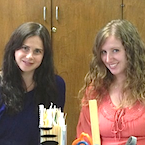The Future of History
A MiddleWeb Blog
In a new MiddleWeb blog, three outstanding middle grades teachers explore the Future of History in a connected world, from multiple perspectives. We hope you’ll join the conversation!
by Shara Peters, Jody Passanisi and Aaron Brock
The future of history depends on its connection to the present.
Some students have trouble relating to the events in history. No matter where they are (an independent or public school – an urban, suburban or rural environment), the study of history can, at times, seem disconnected from the students’ experiences. History teachers attempt to bridge this divide, trying to make figures from the past come to life, and to make events relatable and relevant.
In order to give a broader understanding of the experience of teaching social studies across different settings, Jody and Shara will blog about the ways they try to bridge the divide between the past and the present from their perspectives as independent school teachers in Los Angeles.
Aaron Brock, a teacher in the Compton (CA) Unified School District, will do the same from his public, urban perspective. The three of us have collaborated on aspects of our eighth grade U.S. History curriculum and will at times join blogging forces to look at the same topic from our different perspectives.
Jody Passanisi and Shara Peters
Eighth Grade U.S. History in an Independent School
What is the “Future of History?” Our Philosophy
What is the Future of History in the classroom? One thing is certain: it is not going to look like our own middle school history experience. In eighth grade, we received a study guide that was basically an outline of the textbook and were required to fill in the information from the text. This, repeated week after week, was most of our curriculum. What do we remember? …not so much.
With the advent of the Internet, social studies pedagogy has to be vastly different than it was. With information available to everyone, the value of memorizing facts and details about historical events, people, and places is, well, just not all that valuable anymore.
So then, what should the study of history look like? Students don’t need to know just the “who, what, where, when, why” of history, since that information is readily available online. More importantly, they need to know the significance of those events. Students in the 21st century history classroom need to be able to evaluate and analyze more than they need to be able to remember facts. They should be able to work together to discern the most important points from a swath of the abundant available information. They need to be able to synthesize information learned in history across disciplines. In short, the study of history in middle school is more complex now than it was when we were growing up.
We strive to be reflective practitioners in our approach to teaching history. This reflection has led us to be huge proponents of constructivist, student-centered learning experiences, and we look at history curriculum and strategies through this lens. In our classrooms, we strive to find teaching tools and techniques that will help encourage our students to work collaboratively and think critically.
Three years ago, our students defined history as: “…a narrative of a series of events that is pieced together from evidence and the opinions of interpreters.” It is our goal to push students to identify and analyze these perspectives in history in order to gain analytical skills, as well as a more nuanced view of historical events. To that end, we teach students to detect bias and to write about these historical events with author’s perspective in mind. We aid the students in uncovering information, analyzing that information, synthesizing and connecting broader themes, events, and historical trends, and evaluating historical choices.
Our Setting
While our independent school’s history curriculum is informed and guided by the California State Standards (and now, the Common Core Standards), we have a great deal of autonomy in planning and executing lessons that we feel are meaningful and purposeful. We are supported by our administration in this and have the creative space to be able to develop our curriculum. We are lucky enough to have many technological resources at our disposal (iPads, Smartboards, etc.) so that we can incorporate technology into our lessons and our students’ learning experiences. Many of our students also have access to their own technological, internet-based devices.
As history teachers in the 21st century, one way we make learning history relevant to our students is to help them incorporate our content with skills they can use. By integrating technology and preparing students for the world we can only imagine, we bridge the study of history to the 21st Century.
Our Hopes for the “Future of History” Blog

Also, we will keep an eye on the horizon for new teaching tools that can have an impact on our discipline, and write about what we find. We hope that in doing this we will become even more reflective practitioners, examining what we are doing in our social studies classroom. Even more, we hope to be able to learn from contributions from our readers about what is working in your classrooms.
Though we teach U.S. History in the eighth grade, we will look at strategies, pedagogies, and historical themes that can be applied to other middle grade social studies content areas.”
Aaron Brock
Eighth Grade U.S. History in a Public School
What is the “Future of History” in public schools? My Philosophy
Every year my district brings in a new consultant during the first week of school to rehash sound pedagogical practice. The most significant difference between any of these motivational speakers is the preferred shape of the bullets in their PowerPoint presentations. The message is always the same: we must promote critical thinking and engage students actively in the learning process.

Unfortunately, my district is by no means unique in this respect. And while this experience rings true for public school teachers in any subject, historical instruction feels particularly vulnerable to such inconsistency in educational policy. As a traditionally “boring” subject in which few adolescents see any inherent value, it is often seen as the history teacher’s job to liven up the classroom and make history relevant. Visiting principals or superintendents are frequently most impressed by those classrooms in which students are engaged in a lively debate or in the midst of a hands-on project. Unfortunately, such activities rarely leave time to cover all of the content on district standardized tests.
What then, is our job? Is it possible to cover all of the content, promote all of the necessary skills, and at the same time keep students engaged? No. It is not.
We must, at some point, decide what is best for our students. Whether this is knowing their rights according the Fourth Amendment of the U.S. Constitution or being able to recognize the bias of a primary source document depends on the character of the class and the skill level of each individual student. This means that our curriculum cannot be static, and our teaching must adapt to the needs of each new group of students. History is the study of change in human patterns and behavior over time. If we do not change with history, we risk being left in the past.
My Setting
The preferred euphemism for my work environment is “urban school district.” This politely describes an area in which a majority of the students are poor and academically behind. Few of my students read at grade level, and most have difficulty with texts of any kind. They also face a range of other challenges that, while not directly related to school, have a very real and significant impact on their academic performance. My access to technology in the classroom is inconsistent, and easily half of my students do not have computers or access to the internet at home. Research and independent reading assignments are, at best, extremely difficult for my students to complete outside of class.
My limited resources and the literacy level of my students have led me to write many of the texts used in my classroom. While this is time-consuming, it allows me to tailor lessons more closely to the needs of my students. My primary goal is to help students improve their reading and writing skills; historical content is merely the vehicle by which we work toward that goal.
My Hopes for the “Future of History” Blog

Even when engaging broad themes, I will attempt to provide concrete examples and lessons that I hope other teachers will be able to adapt and use for their own classrooms. I look forward to getting ideas and resources from other teachers and discussing our successes and challenges in an open and supportive forum.
The Future of History is Now . . .
Just as history is shaped by those who lived through it, the study of history is shaped by those who research, think and write about it. If as educators, we want our students to consider historical ideas and address important historical questions, we, too must engage in dialogue about what history was, is and can be. We sincerely hope that our posts on this blog will open up a dialogue in which we talk about content, strategy, practice, grading, setting, and the broader concepts of history and education themselves. The Future of History is now.
_____
Aaron Brock has been a middle school social studies teacher in the Compton Unified School District for five years. He has a BA in History from California State University Northridge and received his teaching credential through University of California Los Angeles’ TeachLA program. His love of history dates back to his own adolescence, and it is his goal to help students discover the aspects of history about which they can get excited. Follow Aaron on Twitter @HistoryBrock.
Jody Passanisi is an eighth grade U.S. History teacher at an independent school in the Los Angeles area. She earned her teaching credential and an M.S. in education from Mount St. Mary’s College and an M.A. in religious studies from the Graduate Theological Union.
Shara Peters teaches eighth grade U.S. History in a Los Angeles independent school. She earned her teaching credential from Hebrew Union College and her M.A. in teaching from American Jewish University.
Jody and Shara’s articles have been featured at the Scientific American blog and at Education Week Teacher. Follow them their blog and on Twitter @21centuryteachr.





































This is a great idea and will be a great resource to so many. I just retired after 33 years in the middle school and now serve as president of the NJ Association of Middle Level Educators. I will share your posts with our members.
I have spent the last couple of years working tirelessly to get students to see different perspectives and issues on events in history (as well as current events). I use a tool called SCAN. It guides kids through 4 critical thinking steps (See the issues, Clarify, Assess what’s important and Now, what should be done?) using different scenarios. (With a subscription, you can even write your own.
I am currently writing a scenario on the Patriot Act and Cell Phone records – a great way to get kids to look at the 4th Amendment which I will post on my blog tomorrow. Check it out, it may be a great way to help your kids explore different perspectives and get the connections!
[Editor’s note: Sandra Wozniak is the Director of Curriculum and Technology for SCAN.]
Thanks for commenting, and thank you for the resources. Read the post on privacy vs. security. Great way to bring these current issues into the classroom and to look at different perspectives on the same legal/ethical question. Connects to our newest piece on current events, too. Thanks again!